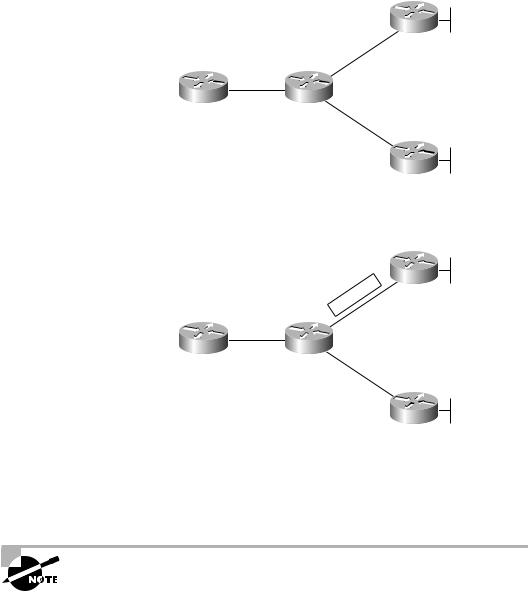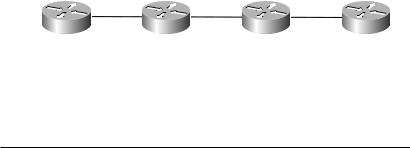
- •Acknowledgments
- •Introduction
- •Assessment Test
- •Answers to Assessment Test
- •Service Provider Networks
- •Scalability
- •Traffic Engineering
- •Quality of Service
- •MPLS Label Stack
- •Shim Header
- •MPLS Architecture
- •Control
- •Forwarding
- •MPLS Label Switching
- •MPLS Network Components
- •Device Output
- •Label-Switched Paths
- •MPLS Applications
- •MPLS and ATM
- •Overlay
- •Quality of Service
- •Traffic Engineering
- •Summary
- •Exam Essentials
- •Key Terms
- •Review Questions
- •Answers to Review Questions
- •Routing Review
- •Frame-Mode MPLS Working Example
- •Network Routing Protocol Examples
- •MPLS Step by Step
- •Label Distribution
- •Assigning Labels
- •Troubleshooting and Verification
- •Device Configuration
- •IGP Verification
- •CEF Verification
- •MPLS Verification
- •Label Distribution and Bindings
- •Binding Verification
- •Troubleshooting the Network
- •Hiding Service Provider Devices
- •Summary
- •Exam Essentials
- •Key Terms
- •Review Questions
- •Answers to Review Questions
- •Frame-Mode MPLS and ATM
- •Frame-Mode MPLS and ATM Configuration
- •Cell-Mode MPLS
- •Label Binding with ATM
- •Cell-Mode Label Switching
- •VC Merge
- •Loop Prevention
- •Cell-Mode MPLS Configuration
- •Summary
- •Exam Essentials
- •Key Terms
- •Review Questions
- •Answers to Review Questions
- •VPNs 101
- •Point-to-Point Connections
- •Virtual Private Networks
- •Categories of VPNs
- •VPN Routing
- •Peer-to-Peer VPNs
- •Optimal Routing
- •Peer-to-Peer Security
- •Peer-to-Peer VPN Routing
- •Summary
- •Exam Essentials
- •Key Terms
- •Review Questions
- •Answers to Review Questions
- •Service Provider Configuration
- •MPLS VPNs
- •Virtual Router
- •Virtual Routing and Forwarding Tables
- •MPLS Operational Overview
- •MP-BGP Configuration
- •An MPLS VPN Example
- •Route Distinguisher
- •MP-IBGP Configuration Example
- •Initial Network Configuration
- •MP-IBGP Configuration
- •Verification
- •Summary
- •Exam Essentials
- •Key Terms
- •Review Questions
- •Answers to Review Questions
- •A Review of VPNs
- •Configuring a Simple MPLS VPN
- •Configuring VRF Interfaces
- •Running RIP in an MPLS VPN
- •Configuring RIPv2 with Address-Family ipv4
- •Configuring Redistribution
- •Route Targets
- •Configuring Route Targets
- •A Review of Simple VPN Configuration
- •Configuring MPLS in the Service Provider Network
- •Simple VPN Configuration
- •Configuring the PE-CE Routing Protocol
- •Lab: Configuring an MPLS VPN
- •Configuring POP Routers
- •VPN Configuration
- •Raleigh Running-Config
- •Atlanta Running-Config
- •Peer 1 Running-Config
- •Peer 2 Running-Config
- •Verification with Ping
- •Routing Table Isolation
- •Verifying VRF Routes
- •Summary
- •Exam Essentials
- •Key Terms
- •Review Questions
- •Answers to Review Questions
- •MP-BGP and OSPF
- •A Review of OSPF
- •OSPF Router Types
- •Link State Advertisements
- •OSPF for MPLS VPNs
- •OSPF Super-Backbone
- •Preventing Routing Loops
- •Path Selection
- •MPLS VPN OSPF Lab
- •Summary
- •Exam Essentials
- •Key Terms
- •Review Questions
- •Answers to Review Questions
- •Static Routing
- •Device Configuration
- •VPN Configuration
- •Raleigh Running-Config
- •Atlanta Running-Config
- •Peer Router Configuration
- •Verification with Ping
- •Verifying Static VRF Routes
- •E-BGP and MPLS VPNs
- •Device Configuration
- •E-BGP Operation
- •AS-Override
- •VPN Configuration
- •Raleigh Running-Config
- •Atlanta Running-Config
- •Peer Router Configuration
- •Peer 1 Running-Config
- •Peer 2 Running-Config
- •Verification with Ping
- •Advanced MPLS VPN Topologies
- •Simple VPNs
- •Central Services MPLS VPN Topology
- •Overlay MPLS VPN Topology
- •Summary
- •Exam Essentials
- •Key Terms
- •Review Questions
- •Answers to Review Questions
- •Challenge Lab 1
- •MPLS
- •MP-IBGP
- •Answer to Lab 1.1
- •Answer to Lab 1.2
- •Answer to Lab 1.3
- •Challenge Lab 2
- •Tag Switching
- •MP-IBGP
- •Answer to Lab 2.1
- •Answer to Lab 2.2
- •Answer to Lab 2.3
- •Challenge Lab 3
- •VRF Configuration
- •RIPv2
- •Redistribution
- •Answer to Lab 3.1
- •Answer to Lab 3.2
- •Answer to Lab 3.3
- •Challenge Lab 4
- •VRF Configuration
- •OSPF
- •Redistribution
- •Answer to Lab 4.1
- •Answer to Lab 4.2
- •Answer to Lab 4.3
- •Challenge Lab 5
- •VRF Configuration
- •Static Routes and Redistribution
- •Answer to Lab 5.1
- •Answer to Lab 5.2
- •Challenge Lab 6
- •VRF Configuration
- •E-BGP Configuration
- •Answer to Lab 6.1
- •Answer to Lab 6.2
- •Service Provider Network Configuration with OSPF
- •Router Configuration
- •Routing Tables
- •Tags
- •Service Provider Network Configuration with IS-IS
- •Router Configuration
- •Routing Tables
- •Tag Switching Forwarding Tables
- •Glossary

MPLS VPNs 165
10.1.0.0 network for Customer X and propagated that to P2. When a packet arrives at PE2, the router sees the VPN label first. Since PE2 assigned the label, it knows exactly where the packet goes.
F I G U R E 5 . 5 Forwarding packets without labels on VPNs with overlapping network addresses
Customer X 10.1.0.0/16
IP |
L |
|
IP |
|
|
|
P2 |
|
PE2 |
Customer Y 10.1.0.0/16
F I G U R E 5 . 6 Forwarding packets with labels on VPNs with overlapping network addresses
|
|
|
|
|
|
Customer X |
10.1.0.0/16 |
|
|
|
|
|
|
|
|
|
|
|
|
|
|
IP |
|
|
|
|
|
|
|
|
|
IP |
32 |
L |
|
IP |
32 |
|
|
|
|
|
P2 |
|
|
PE2 |
|
|
|
|
|
|
|
Customer Y |
10.1.0.0/16 |
|
|
|
|
|
|
|
MP-BGP Configuration
MP-BGP must be configured between all routers that need to propagate or exchange VPN routes.
VPN routes are referred to as VPN version 4 (VPNv4) routes.
Copyright ©2002 SYBEX, Inc., Alameda, CA |
www.sybex.com |

166 Chapter 5 MPLS VPNs
To configure MP-BGP, the address-family vpnv4 command is used from within the traditional BGP configuration. An address family is sometimes referred to as a routing context. In this case, the address family vpnv4 command is used within global BGP configuration. Therefore, this special context does not need a new BGP process. (Only one BGP is supported on a Cisco IOS router.) Neighbors, if already configured in global BGP, simply need to be activated.
Communities must be configured as well. There are two types of communities: extended and standard. Standard communities have not been replaced by extended communities. It is necessary to specify extended communities between MP-BGP neighbors for proper VPN operation. The default operation of BGP is to send no community values. Therefore, you must manually configure MP-BGP to send both standard and extended communities.
Based on the configuration illustrated in Figure 5.1 earlier in this chapter, the final task is to configure MP-BGP between PE1 and PE2. Just to refresh your memory, Figure 5.7 illustrates the example service provider network.
F I G U R E 5 . 7 A service provider network
Serial |
0/0 |
Serial |
0/0 |
Serial |
0/1 |
Serial |
0/0 |
Serial |
0/1 |
Serial |
0/0 |
|
|
|
|
|
|
PE1 P1 P2 PE2
Table 5.2 lists the IP addresses and interfaces for all the devices in the service provider network in Figure 5.7.
T A B L E 5 . 2 Service Provider IP Addressing
Device |
Serial 0/0 |
Serial 0/1 |
Loopback 0 |
|
|
|
|
PE1 |
192.168.1.10 |
|
192.168.1.1 |
P1 |
192.168.1.9 |
192.168.1.14 |
192.168.1.2 |
P2 |
192.168.1.13 |
192.168.1.18 |
192.168.1.3 |
PE2 |
192.168.1.17 |
|
192.168.1.4 |
|
|
|
|
Copyright ©2002 SYBEX, Inc., Alameda, CA |
www.sybex.com |

MPLS VPNs 167
On the PE1 router, you configure MP-BGP with the following commands:
PE1#config t
PE1(config)#router bgp 1 PE1(config-router)#address-family vpnv4
PE1(config-router)#neighbor 192.168.1.4 activate PE1(config-router)#neighbor 192.168.1.4 next-hop self PE1(config-router)#neighbor 192.168.1.4 send-community both
On the PE2 router, you configure MP-BGP with the following commands:
PE2#config t
PE2(config)#router bgp 1 PE2(config-router)#address-family vpnv4
PE2(config-router)#neighbor 192.168.1.1 activate PE2(config-router)#neighbor 192.168.1.1 next-hop self PE1(config-router)#neighbor 192.168.1.1 send-community both
A sample output from the show running-config command is as follows. In this output, locate the global BGP commands and then the MP-BGP commands under the address-family vpnv4 section:
router bgp 1
no synchronization
network 192.168.1.1 mask 255.255.255.255 neighbor 192.168.1.4 remote-as 1
neighbor 192.168.1.4 update-source Loopback0 redistribute static
!
address-family vpnv4
neighbor 192.168.1.4 activate neighbor 192.168.1.4 next-hop self
neighbor 192.168.1.4 send-community both
Neighbors are first specified in global BGP, and then for MP-BGP, neighbors
are activated.
Copyright ©2002 SYBEX, Inc., Alameda, CA |
www.sybex.com |
